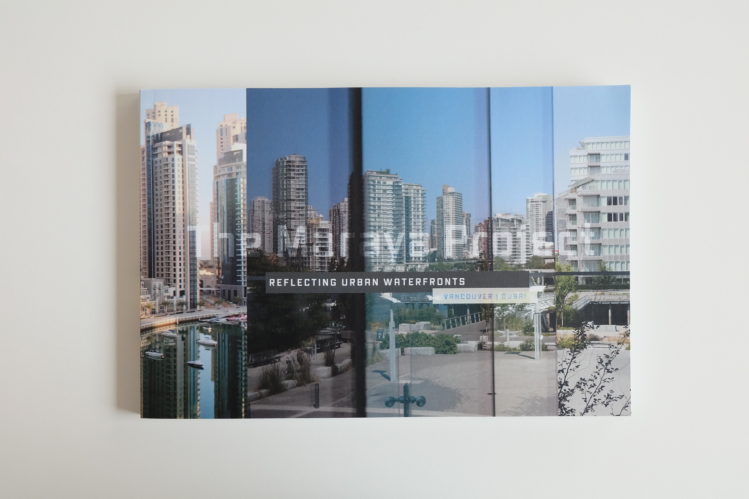
Friday, May 6, 2022, 5 – 7 PM PDT
Join us at Centre A for the official book launch of “The Maraya Project: Reflecting Urban Waterfronts: Vancouver | Dubai” by M. Simon Levin, Glen Lowry, and Henry Tsang.
Register HERE.
—
The Maraya Project documents the collaboration of artists M. Simon Levin, Henry Tsang, and writer Glen Lowry as they track the re-appearance of Vancouver’s downtown waterfront in the Arabian desert twelve time zones away. Maraya, which means mirror or reflection in Arabic, focuses on the urban regeneration megaproject in Vancouver’s False Creek that became an impetus for new thinking about 21st-century urban development and how it subsequently shaped one of Dubai’s first master-planned developments, the Dubai Marina.
The publication includes dozens of full-colour photographs, including foldouts, accompanied by poetic texts, descriptions, lists of projects, events, and activities and a foreword by the Maraya team. Central to the book is a long-form essay by Dr. Alice Ming Wai Jim that traces the eight-year interdisciplinary collaboration and posits the Maraya Project as a kind of imaginative worlding research-creation practice that potentially embodies postcolonial urbanism as a critical transnational methodology. Accompanying writings by Robert Ferry and Elizabeth Monoian, and Kevin Hamilton, respectively, provide insight into the experience of living and working in Dubai at a time of sensational and sensationalized growth, as well as reflecting on the experience of pulling the Sisyphean Cart along the waterfronts while considering the relationship between new media artistic practice and colonial spaces.
An early iteration of Maraya curated by Makiko Hara was exhibited at Centre A in 2011. The 2011 project included an exhibition, a series of public talks, walking tours, and a commissioned interactive website. For the first time in Centre A’s history, the gallery was able to commission the artists to develop an experimental internet platform.
The book is published by Gail and Stephen A. Jarislowsky Institute for Studies in Canadian Art.
The book will be available for purchase for a special discounted price of $25 at the launch (regular $30).
—
Glen Lowry is a researcher, writer, editor, and publisher whose work investigates new forms of critical and creative practice, most often from the perspective of collaborative investigation. Trained as a cultural theorist (PhD English), Lowry works with artists and collectives on projects that look at questions of social justice and emergent publics. He edited the SFU-based cultural journal West Coast LINE (2000-2012), cofounded LINEbooks | Burnaby, and as editor / consultant with the Aboriginal Healing Foundation (2011-2015), travelled across Canada participating in discussions about Truth and Reconciliation. He is currently Executive Director and Advisor to the Provost, Partnerships, Outreach & Research at Ontario College of Art & Design University.
M. Simon Levin has co-created site-based systems that explore the aesthetics of engagement using a variety of designed forms and tools that address our many publics. From large-scale projects in urban environments such as a photo agency for inner city youth, indigenous, medicinal and food-security gardens downtown to a variety of psycho-geographic and psycho-sonic mappings of space, Simon works with diverse communities and audiences towards realising these spatial and pedagogical projects. He has taught in Graduate Studies, Critical and Cultural Studies and Dynamic Media at Emily Carr University of Art and Design and the Department of Art History and Visual Art at UBC. He has published curriculum on Contemporary Public Art, and co-contributed a chapter to Routledge’s Cultural Mapping as Cultural Inquiry. He is currently co-director of Coppermoss Retreat and Residency (est. 2016), situated on the traditional lands of the shíshalh nation in the village of Tuwanek, BC. Seeking to trouble his settler relationship to the land; Coppermoss invites artists up to live and work at the edge of wilderness, fostering new approaches to decolonizing through land-based pedagogy and bio-remediation projects.
Henry Tsang’s projects explore the spatial politics of history, language, community, food and cultural translation in relationship to place. They take the form of gallery exhibitions, pop-up street food offerings, 360 video walking tours, curated dinners, ephemeral and permanent public art, employing video, photography, language, interactive media, food and convivial events. Projects include: Tansy Point, a video installation of the site of the 1851 treaty signings by the Chinook peoples and the US government that were never ratified; 360 Riot Walk, a 360 video walking tour of the 1907 Anti-Asian Riots in Vancouver, Canada; RIOT FOOD HERE, a public offering of food reflecting on the 1907 Riots; video installations Orange County, and Olympus, shot in California, Beijing, Torino and Vancouver, that explore overlapping urban and socio-political spaces; and Welcome to the Land of Light, a public artwork along Vancouver’s seawall that underscores the 19th Century trade language Chinook Jargon and the English that replaced it. He is based on the unceded territories of the Musqueam, Squamish, Sto:lo, and Tsleil- Waututh Peoples.
—
Centre A is wheelchair and walker accessible. Please contact [email protected] with any questions if you require any assistance.
Centre A is situated on the unceded territories of the Musqueam, Squamish, and Tsleil-Waututh peoples. We honour, respect, and give thanks to our hosts.
Notes Regarding the Event:
- Be gently reminded that you will need to be fully vaccinated to attend this event. Face masks or face coverings are encouraged when not drinking or eating. We also encourage you to sanitize your hands before and after visiting. Masks and hand sanitizer are available for you as needed.
- Face masks or face coverings are necessary when you are in the gallery space. We also encourage you to sanitize your hands before and after visiting. Masks and hand sanitizer are available for you as needed.
- Due to Sun Wah Centre’s security measures, please locate the security guard posted at the front gate to be let into the building. Otherwise, please call Centre A at (604) 683-8326 during the event hours.









